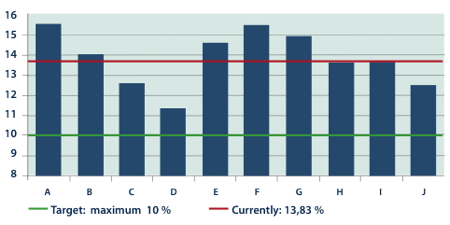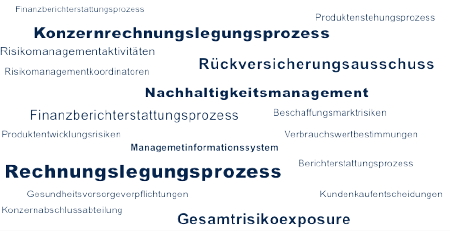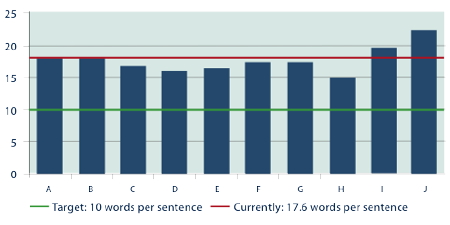Gabi Trillhaas - Analysis
Understandable management reports*
*Translator’s note: The article deals with German texts. However, while some features like word length differ, the gist applies mutatis mutandis to English writing too.
“Unintelligible management reports lead capital markets astray!”
 According to the Commercial Code and Securities Trading Act annual reports – and thus risk reports – have to be self-explanatory and represent the economic situation of the company independently and understandably. in its 2010 annual report BaFin complained that many companies need to catch up here. It points to the risk that the capital markets might draw the wrong conclusions from ambiguous or unclear formulations. How can this be remedied?
According to the Commercial Code and Securities Trading Act annual reports – and thus risk reports – have to be self-explanatory and represent the economic situation of the company independently and understandably. in its 2010 annual report BaFin complained that many companies need to catch up here. It points to the risk that the capital markets might draw the wrong conclusions from ambiguous or unclear formulations. How can this be remedied?
What if ambiguous situation or risk reports tempt capital-market participants into misjudgements? Just think of the risks that lie dormant in the balance sheets of banks and insurance companies. The author of management reports should, then, go to work with care and sensitivity. When it comes to the clear presentation of a company’s risk, it is very easy to get many things right, but also many things wrong.
What factors contribute to (un-)intelligibility?
Why are some texts more difficult to understand as compared to others? Why as a reader do you sometimes feel in the right place, but other times not even addressed? For reading comprehension and reading pleasure, it is especially important for the writer of the text to have an idea whom he is writing for, and how much time, prior knowledge and interest the reader will have. For an attractive writing style, among others the following rules must be considered:
- Technical terms should be explained at an appropriate place or be avoided altogether.
- Foreign-language expressions may be familiar to the company's employees, but not to readers of annual reports.
- Long sentences are generally harder to understand than short ones.
- Complicated sentences with references or inserted explanations are worse than bullet points and clear, concise statements.
- Passive sentences are harder to understand than active sentences.
- Excessively converting verbs into nouns gives the impression of an impersonal nominal style, also called officialese or legalese.
- The eye wants to be led, and likes pictures and graphics.
- Acres of print are simply not inviting!
- A clear structure makes it easier to find information.
- When several authors have collaborated on a text, the different writing styles should be harmonized.
Other factors should not be underestimated: for example typography, grammar, spelling, logical structure, consistency.
Intelligibility can be measured
In November 2011, the German Share Institute organized a seminar to present the results of the financial reporting competition. Here, exameo GmbH, the European Institute for understandable information, presented results from a study on the comprehensibility of the risk reports of 10 DAX companies. The companies’ reports were compared in the following categories: word and sentence length, proportion of difficult words, quality of explanations of technical terms and effect of different writing styles.
During the investigation, it was a question less of absolute test results than how much the individual texts differ. In measuring long words (> 12 letters), it was striking that the share of the individual DAX companies varies greatly (Figure 1). If, on average, nearly 14 percent of the words of a text have more than 12 letters, then this means that every seventh word is too long!

Figure 1: Proportion of long words (> 12 letters)
Source: exameo GmbH
Taking a look at these long words, it quickly becomes clear why the average word length is so high (Figure 2). It is a matter of central technical terms that are necessary for the understanding of the facts:

Figure 2: Examples of complicated words
Source: exameo GmbH
Looking at the average sentence length, the picture is uniform, but unsightly (Figure 3). Too many long sentences spoil the (reading) broth. If each sentence contains on average 17 words, then the reader has a lot to digest, and needs to concentrate hard. The longest sentence, with no less than 73 words, really showed some nerve!

Figure 3: Average sentence length
Source: exameo GmbH
Passive or Active?
In a good text, active and passive formulations should be judiciously mixed. Especially in risk reports, however, passive sentences often predominate. The German term “suffering form” expresses what this style is about: responsibility is unclear. Hazards “arise”, plans “are created”, tests “simulated”. “It” is defined, considered, explained – but by whom? Anonymity and powerlessness rule. The reader is left with uncertainty about who has the say here in the company, who recognizes the danger and takes precautions to control risks. The members of the Board, who on the first pages of the annual report have everything under control, like anonymous forces to be at work in the risk report.
Nowhere else is it so clear what possibilities open up here: the passive springs to mind when we want to show how helpless the company is in the face of the storms of the markets. Conversely, the author can use active formulations if he wants to to point out how farseeingly and risk-aware the leaders act: “We” examine, define, deploy instruments, plan, explain ...
Implement findings specifically
What has been objectively measured can be systematically improved. In other words, objective measurement results are an important prerequisite in order to identify weak points and improve texts. Difficulty of understanding is curable.
Gabi Trillhaas is the managing director of exameo GmbH, the European Institute for understandable information. exameo checks the comprehensibility of texts and helps companies see the need for optimization.
Gabi Trillhaas
exameo GmbH
24.11.2011















